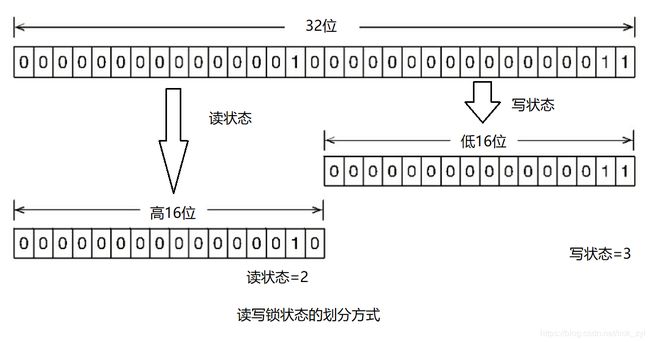JAVA并发-读写锁
读写锁
不同于互斥锁和重入锁,读写锁在同一时刻可以允许多个读线程访问,但是在写线程访问时,所有的读线程和其他写线程均被阻塞。读写锁维护了一对锁,一个读锁和一个写锁,通过分离读锁和写锁,使得并发性相比一般的排他锁有了很大提升。
读写锁在实现多线程同时读,写线程阻塞所有其它读写线程的功能时,只需要在读操作时获取读锁,写操作时获取写锁即可。
一般情况下,读写锁的性能都会比排它锁好,因为大多数场景读是多于写的。在读多写少的情况下,读写锁能够提供比排它锁更好的并发性和吞吐量。Java并发包提供读写锁的实现是 ReentrantReadWriteLock,它提供的特性如下表所示:
| 特性 | 说明 |
|---|---|
| 公平性选择 | 支持非公平(默认)和公平的锁获取方式,吞吐量方面非公平优于公平 |
| 重进入 | 该锁支持重进入,以读写线程为例: 读线程在获取了读锁之后,能够再次获取读锁。 而写线程在获取了写锁之后能够再次获取写锁,同时也可以获取读锁 |
| 锁降级 | 遵循获取写锁、获取读锁再释放写锁的次序,写锁能够降级成为读锁 |
一、读写锁的接口与示例
ReadWriteLock仅定义了获取读锁和写锁的两个方法,即readLock()方法和writeLock()方 法,而其实现——ReentrantReadWriteLock,除了接口方法之外,还提供了一些便于外界监控其内部工作状态的方法,这些方法以及描述如下:
/**
* Queries the number of read locks held for this lock. This
* method is designed for use in monitoring system state, not for
* synchronization control.
* @return the number of read locks held
*/
public int getReadLockCount() {
//该次数不等于获取读锁的线程数, 因为同一线程可能多次获取读锁, 该值会不断累加
return sync.getReadLockCount();
}
/**
* Queries if the write lock is held by any thread. This method is
* designed for use in monitoring system state, not for
* synchronization control.
*
* @return {@code true} if any thread holds the write lock and
* {@code false} otherwise
*/
public boolean isWriteLocked() {
return sync.isWriteLocked();
}
/**
* Queries if the write lock is held by the current thread.
*
* @return {@code true} if the current thread holds the write lock and
* {@code false} otherwise
*/
public boolean isWriteLockedByCurrentThread() {
return sync.isHeldExclusively();
}
/**
* Queries the number of reentrant write holds on this lock by the
* current thread. A writer thread has a hold on a lock for
* each lock action that is not matched by an unlock action.
*
* @return the number of holds on the write lock by the current thread,
* or zero if the write lock is not held by the current thread
*/
public int getWriteHoldCount() {
return sync.getWriteHoldCount();
}
/**
* Queries the number of reentrant read holds on this lock by the
* current thread. A reader thread has a hold on a lock for
* each lock action that is not matched by an unlock action.
*
* @return the number of holds on the read lock by the current thread,
* or zero if the read lock is not held by the current thread
* @since 1.6
*/
public int getReadHoldCount() {
return sync.getReadHoldCount();
}
接下来,通过一个缓存示例说明读写锁的使用方式,示例代码如下:
public class Cache {
static Map<String, Object> map = new HashMap<String, Object>();
static ReentrantReadWriteLock rwl = new ReentrantReadWriteLock();
static Lock r = rwl.readLock();
static Lock w = rwl.writeLock();
//获取一个key对应的value
public static final Object get(String key) {
r.lock();
try {
return map.get(key);
} finally {
r.unlock();
}
}
// 设置key对应的value,并返回旧的value
public static final Object put(String key, Object value) {
w.lock();
try {
return map.put(key, value);
} finally {
w.unlock();
}
}
// 清空所有的内容
public static final void clear() {
w.lock();
try {
map.clear();
} finally {
w.unlock();
}
}
}
上述示例中,Cache组合一个非线程安全的HashMap作为缓存的实现,同时使用读写锁的 读锁和写锁来保证Cache是线程安全的。在读操作get(String key)方法中,需要获取读锁,这使得并发访问该方法时不会被阻塞。写操作put(String key,Object value)方法和clear()方法,在更新HashMap时必须提前获取写锁,当获取写锁后,其他线程对于读锁和写锁的获取均被阻塞,而只有写锁被释放之后,其他读写操作才能继续。Cache使用读写锁提升读操作的并发性,也保证每次写操作对所有的读写操作的可见性,同时简化了编程方式。
二、读写锁的实现分析
1. 读写状态的设计
读写锁同样依赖自定义同步器来实现同步功能,而读写状态就是其同步器的同步状态。 回想ReentrantLock中自定义同步器的实现,同步状态表示锁被一个线程重复获取的次数,而读写锁的自定义同步器需要在同步状态(一个整型变量)上维护多个读线程和一个写线程的状态,使得该状态的设计成为读写锁实现的关键。
如果在一个整型变量上维护多种状态,就一定需要“按位切割使用”这个变量,读写锁将变量切分成了两个部分,高16位表示读,低16位表示写,划分方式如下图所示:

当前同步状态表示一个线程已经获取了写锁,且重进入了两次,同时也连续获取了两次读锁。读写锁是如何迅速确定读和写各自的状态呢?答案是通过位运算。假设当前同步状态值为S,写状态等于S&0x0000FFFF(将高16位全部抹去),读状态等于S>>>16(无符号补0右移 16位)。当写状态增加1时,等于S+1,当读状态增加1时,等于S+(1<<16),也就是 S+0x00010000。
根据状态的划分能得出一个推论:S不等于0时,当写状态(S&0x0000FFFF)等于0时,则读 状态(S>>>16)大于0,即读锁已被获取。
3. 写锁的获取与释放
写锁是一个支持重进入的排它锁。如果当前线程已经获取了写锁,则增加写状态。如果当前线程在获取写锁时,读锁已经被获取(读状态不为0)或者该线程不是已经获取写锁的线程,则当前线程进入等待状态,ReentrantReadWriteLock的tryAcquire方法源码如下:
protected final boolean tryAcquire(int acquires) {
/*
* Walkthrough:
* 1. If read count nonzero or write count nonzero
* and owner is a different thread, fail.
* 2. If count would saturate, fail. (This can only
* happen if count is already nonzero.)
* 3. Otherwise, this thread is eligible for lock if
* it is either a reentrant acquire or
* queue policy allows it. If so, update state
* and set owner.
*/
Thread current = Thread.currentThread();
int c = getState();
int w = exclusiveCount(c);
if (c != 0) {
// (Note: if c != 0 and w == 0 then shared count != 0)
if (w == 0 || current != getExclusiveOwnerThread())
return false;
if (w + exclusiveCount(acquires) > MAX_COUNT)
throw new Error("Maximum lock count exceeded");
// Reentrant acquire
setState(c + acquires);
return true;
}
if (writerShouldBlock() ||
!compareAndSetState(c, c + acquires))
return false;
setExclusiveOwnerThread(current);
return true;
}
该方法除了重入条件(当前线程为获取了写锁的线程)之外,增加了一个读锁是否存在的
判断。如果存在读锁,则写锁不能被获取,原因在于:读写锁要确保写锁的操作对读锁可见,如果允许读锁在已被获取的情况下对写锁的获取,那么正在运行的其他读线程就无法感知到当前写线程的操作。因此,只有等待其他读线程都释放了读锁,写锁才能被当前线程获取,而写锁一旦被获取,则其他读写线程的后续访问均被阻塞。
写锁的释放与ReentrantLock的释放过程基本类似,每次释放均减少写状态,当写状态为0 时表示写锁已被释放,从而等待的读写线程能够继续访问读写锁,同时前次写线程的修改对后续读写线程可见。
4. 读锁的获取与释放
读锁是一个支持重进入的共享锁,它能够被多个线程同时获取,
- 在没有其他写线程访问 (或者写状态为0)时,读锁总会被成功地获取,而所做的也只是(线程安全的)增加读状态。
- 如果当前线程已经获取了读锁,则增加读状态。
- 如果当前线程在获取读锁时,写锁已被其他线程获取,则进入等待状态。
获取读锁的实现从Java 5到Java 6变得复杂许多,主要原因是新增了一 些功能,例如getReadHoldCount()方法,作用是返回当前线程获取读锁的次数。读状态是所有线程获取读锁次数的总和,而每个线程各自获取读锁的次数只能选择保存在ThreadLocal中,由线程自身维护,这使获取读锁的实现变得复杂。ReentrantReadWriteLock的tryAcquireShared方法和tryReleaseShared方法源码如下:
protected final int tryAcquireShared(int unused) {
/*
* Walkthrough:
* 1. If write lock held by another thread, fail.
* 2. Otherwise, this thread is eligible for
* lock wrt state, so ask if it should block
* because of queue policy. If not, try
* to grant by CASing state and updating count.
* Note that step does not check for reentrant
* acquires, which is postponed to full version
* to avoid having to check hold count in
* the more typical non-reentrant case.
* 3. If step 2 fails either because thread
* apparently not eligible or CAS fails or count
* saturated, chain to version with full retry loop.
*/
Thread current = Thread.currentThread();
int c = getState();
if (exclusiveCount(c) != 0 &&
getExclusiveOwnerThread() != current)
return -1;
int r = sharedCount(c);
if (!readerShouldBlock() &&
r < MAX_COUNT &&
compareAndSetState(c, c + SHARED_UNIT)) {
if (r == 0) {
firstReader = current;
firstReaderHoldCount = 1;
} else if (firstReader == current) {
firstReaderHoldCount++;
} else {
HoldCounter rh = cachedHoldCounter;
if (rh == null || rh.tid != getThreadId(current))
cachedHoldCounter = rh = readHolds.get();
else if (rh.count == 0)
readHolds.set(rh);
rh.count++;
}
return 1;
}
return fullTryAcquireShared(current);
}
protected final boolean tryReleaseShared(int unused) {
Thread current = Thread.currentThread();
if (firstReader == current) {
// assert firstReaderHoldCount > 0;
if (firstReaderHoldCount == 1)
firstReader = null;
else
firstReaderHoldCount--;
} else {
HoldCounter rh = cachedHoldCounter;
if (rh == null || rh.tid != getThreadId(current))
rh = readHolds.get();
int count = rh.count;
if (count <= 1) {
readHolds.remove();
if (count <= 0)
throw unmatchedUnlockException();
}
--rh.count;
}
for (;;) {
int c = getState();
int nextc = c - SHARED_UNIT; // (1 << 16)
if (compareAndSetState(c, nextc))
// Releasing the read lock has no effect on readers,
// but it may allow waiting writers to proceed if
// both read and write locks are now free.
return nextc == 0;
}
}
5. 锁降级
锁降级指的是写锁降级成为读锁。如果当前线程拥有写锁,然后将其释放,最后再获取读锁,这种分段完成的过程不能称之为锁降级。锁降级是指把持住(当前拥有的)写锁,再获取到读锁,随后释放(先前拥有的)写锁的过程。
下面是一个锁降级的示例,因为数据不常变化,所以多个线程可以并发地进行数据处理,当数据变更后,如果当前线程感知到数据变化,则进行数据的准备工作,同时其他处理线程被阻塞,直到当前线程完成数据的准备工作,示例方法代码如下:
public void processData() {
readLock.lock();
if (!update) {
readLock.unlock();// 必须先释放读锁
writeLock.lock(); // 锁降级从写锁获取到开始
try {
if (!update) {
// 准备数据的流程(略)
update = true;
}
readLock.lock();
} finally {
writeLock.unlock();
}
// 锁降级完成,写锁降级为读锁
}
try {
// 使用数据的流程(略)
} finally {
readLock.unlock();
}
}
上述示例中,当数据发生变更后,update变量(布尔类型且volatile修饰)被设置为false,此时所有访问processData()方法的线程都能够感知到变化,但只有一个线程能够获取到写锁,其他线程会被阻塞在读锁和写锁的lock()方法上。当前线程获取写锁完成数据准备之后,再获取读锁,随后释放写锁,完成锁降级。
锁降级中读锁的获取是否必要呢?答案是必要的。主要是为了保证数据的可见性,如果当前线程不获取读锁而是直接释放写锁,假设此刻另一个线程(记作线程T)获取了写锁并修改了数据,那么当前线程无法感知线程T的数据更新。如果当前线程获取读锁,即遵循锁降级的步骤,则线程T将会被阻塞,直到当前线程使用数据并释放读锁之后,线程T才能获取写锁进行数据更新。
RentrantReadWriteLock不支持锁升级(把持读锁、获取写锁,最后释放读锁的过程)。目的也是保证数据可见性,如果读锁已被多个线程获取,其中任意线程成功获取了写锁并更新了数据,则其更新对其他获取到读锁的线程是不可见的。
参考《java并发编程的艺术》-方腾飞